The Science and Methodology Behind Hair Brushing in Hairdressing
Hair brushing is not just a simple act of grooming; it’s an essential practice in maintaining hair health and promoting scalp vitality. While many overlook its importance, understanding the nuances of brushing can profoundly impact the health, shine, and vitality of hair. This article sheds light on the role of hair brushing in a hairdresser’s work, explaining its benefits and outlining when it should be avoided.

Benefits of Proper Hair Brushing
- Microcirculation Stimulation: Brushing the hair with appropriate pressure and technique can enhance the scalp’s blood flow. This microcirculation provides hair follicles with essential nutrients, which can encourage healthier hair growth.
- Detoxification: Daily exposure to the environment means our hair collects dust, dirt, and hairspray buildup. Brushing effectively removes these impurities, ensuring the hair remains clean and vibrant.
- Natural Shine: Brushing helps distribute the hair’s natural oils from the scalp down the hair shaft. This not only nourishes the hair but also imparts a natural shine, making hair look healthier.
- Detangling and Control: Especially beneficial for people with tight curl patterns, brushing helps detangle knots and offers better hair management. However, it’s crucial to approach curly hair with care, often best brushed during or post-conditioning.
Best Practices in Hair Brushing
- Pre-shampooing: For straight to wavy hair types, brushing thoroughly before shampooing can help remove any detritus and prepare the hair for washing.
- Tight Curls Management: It’s imperative to detangle tight curl patterns before wetting them. Wet curls are more fragile and can break easily. Brushing or combing during the conditioning phase can minimize breakage and discomfort.
- During Scalp Treatments: The scalp is sensitive, so when conducting a treatment, brushing needs to be gentle. The aim should be to clear debris without causing any discomfort or overstimulating the scalp.
When to Avoid Brushing
While brushing has its merits, there are times when it should be avoided:
- Scalp Sensitivity: If the scalp shows signs of irritation or inflammation, it’s best to avoid brushing until it heals.
- Chemical Services: Manufacturer’s directions should be the guide here. Typically, it’s recommended to avoid brushing right before chemical treatments to prevent scalp sensitivity.
- Coloring Services: Whether it’s semipermanent, permanent, bleach lightening, or highlighting, brushing can affect the uniform application of the color, leading to uneven results.
- Manufacturer’s Recommendations: Always refer to specific product guidelines. If a shampoo is suggested before a chemical treatment, brush the hair lightly and shampoo gently. Always rinse with cool water to soothe the scalp and keep hair cuticles smooth.
Conclusion
Brushing is not just about aesthetics; it’s an art that combines the nuances of hair health, scalp vitality, and client comfort. It’s a testament to a hairdresser’s commitment to ensuring the best for their client’s hair. By understanding the intricacies of brushing, both hairdressers and clients can enjoy healthier, shinier, and more vibrant hair.







